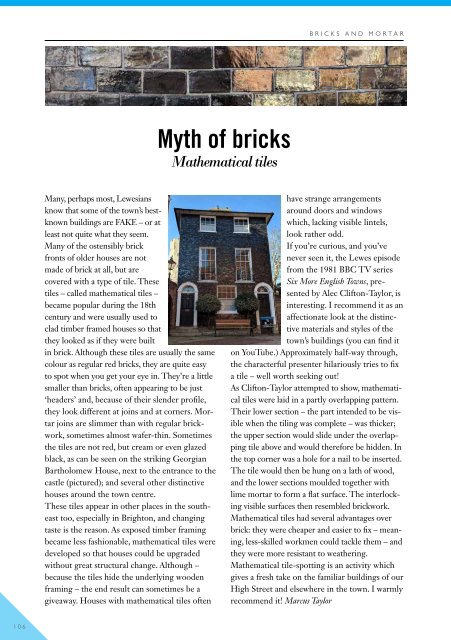Viva Lewes Issue #147 December 2018
Create successful ePaper yourself
Turn your PDF publications into a flip-book with our unique Google optimized e-Paper software.
BRICKS AND MORTAR<br />
Myth of bricks<br />
Mathematical tiles<br />
Many, perhaps most, <strong>Lewes</strong>ians<br />
know that some of the town’s bestknown<br />
buildings are FAKE – or at<br />
least not quite what they seem.<br />
Many of the ostensibly brick<br />
fronts of older houses are not<br />
made of brick at all, but are<br />
covered with a type of tile. These<br />
tiles – called mathematical tiles –<br />
became popular during the 18th<br />
century and were usually used to<br />
clad timber framed houses so that<br />
they looked as if they were built<br />
in brick. Although these tiles are usually the same<br />
colour as regular red bricks, they are quite easy<br />
to spot when you get your eye in. They’re a little<br />
smaller than bricks, often appearing to be just<br />
‘headers’ and, because of their slender profile,<br />
they look different at joins and at corners. Mortar<br />
joins are slimmer than with regular brickwork,<br />
sometimes almost wafer-thin. Sometimes<br />
the tiles are not red, but cream or even glazed<br />
black, as can be seen on the striking Georgian<br />
Bartholomew House, next to the entrance to the<br />
castle (pictured); and several other distinctive<br />
houses around the town centre.<br />
These tiles appear in other places in the southeast<br />
too, especially in Brighton, and changing<br />
taste is the reason. As exposed timber framing<br />
became less fashionable, mathematical tiles were<br />
developed so that houses could be upgraded<br />
without great structural change. Although –<br />
because the tiles hide the underlying wooden<br />
framing – the end result can sometimes be a<br />
giveaway. Houses with mathematical tiles often<br />
have strange arrangements<br />
around doors and windows<br />
which, lacking visible lintels,<br />
look rather odd.<br />
If you’re curious, and you’ve<br />
never seen it, the <strong>Lewes</strong> episode<br />
from the 1981 BBC TV series<br />
Six More English Towns, presented<br />
by Alec Clifton-Taylor, is<br />
interesting. I recommend it as an<br />
affectionate look at the distinctive<br />
materials and styles of the<br />
town’s buildings (you can find it<br />
on YouTube.) Approximately half-way through,<br />
the characterful presenter hilariously tries to fix<br />
a tile – well worth seeking out!<br />
As Clifton-Taylor attempted to show, mathematical<br />
tiles were laid in a partly overlapping pattern.<br />
Their lower section – the part intended to be visible<br />
when the tiling was complete – was thicker;<br />
the upper section would slide under the overlapping<br />
tile above and would therefore be hidden. In<br />
the top corner was a hole for a nail to be inserted.<br />
The tile would then be hung on a lath of wood,<br />
and the lower sections moulded together with<br />
lime mortar to form a flat surface. The interlocking<br />
visible surfaces then resembled brickwork.<br />
Mathematical tiles had several advantages over<br />
brick: they were cheaper and easier to fix – meaning,<br />
less-skilled workmen could tackle them – and<br />
they were more resistant to weathering.<br />
Mathematical tile-spotting is an activity which<br />
gives a fresh take on the familiar buildings of our<br />
High Street and elsewhere in the town. I warmly<br />
recommend it! Marcus Taylor<br />
106


















